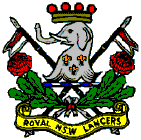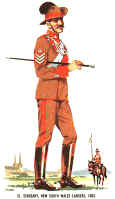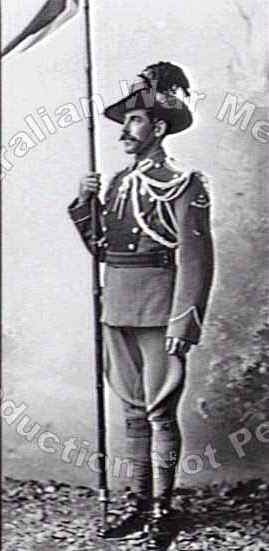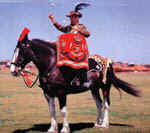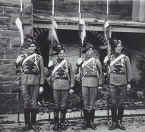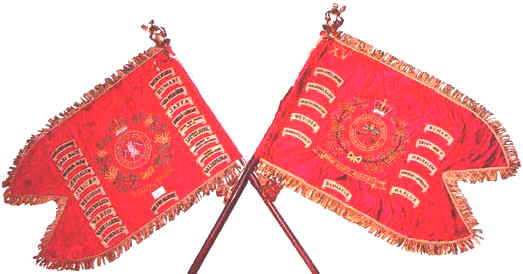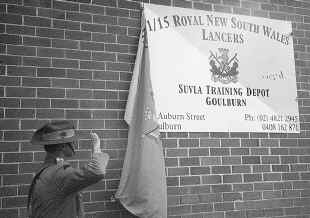 |
|
|||
|
|
||||
|
This squadron, reinforced by further drafts from New South Wales, formed part of General French's Cavalry Division. In the 1914-1918 war, the Regiment being militia, did not serve abroad, however, most of its pre-war members joined the AIF. Subsequently the Lancers were designated as successors to the 1st Light Horse Regiment of the AIF. It had fought at Gallipoli and later in Sinai and Palestine as part of the Desert Mounted Corps. In 1956, the number "15th" was linked with the "1st" making the Regiment also the successor to the 15th Light Horse Regiment, AIF which had been formed in Palestine in 1918 from personnel of the Camel Corps. The Lancers were granted the title "Royal" in 1935. It was horsed until 1936, when it was motorised as a mechanised machine gun regiment.In 1942, it was incorporated into the AIF as an armoured regiment. Equipped with Matilda Infantry Support Tanks, it pioneered the use of tanks in the New Guinea jungle. |
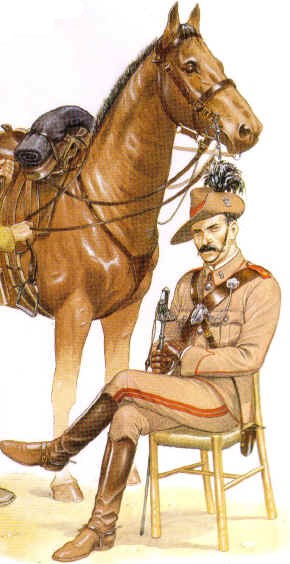 |
Later in the seaborne assault by the 7th Division on Balikpapan in Borneo, the Regiment made the heaviest Australian tank attack of the war. It was the only armoured regiment of
militia origin to go overseas, and the only Australian Armoured Regiment
to be sent overseas twice.
After the war, the regiment was equipped first with Matilda then
Centurion tanks
The Regiment with 21 battle honours, is the most highly decorated unit in the Australian Army. It celebrated its centenary in 1985, and looks forward to serving the nation in the 21st Century.
Commenced in 1818, they were completed in 1820, the architect was Lieutenant John Watts of the 46th Regiment. They were to stand in an area of 3.25ha, and were designed for a company (approximately 100 officers and men). They served as a barracks for British regiments stationed here in convict days. Some of the men would have served under Wellington in the Napoleonic wars.
The original buildings included the two-storey building overlooking
the parade ground and the single storey "Bobs Hall" nearby.
There was also a twin of Bobs Hall, equal and opposite to it. There were
also stables, kitchens, and privies on the perimeter. The three main
buildings form three sides of a square. The walls are of sandstock brick.
The two storey building was of Georgian design; the balcony and verandah
were added in the C1830s.
By this time land had been taken for railway and education purposes, and with the arrival of the Lancers, accommodation was provided for the permanent cadre. An Edwardian House for the Adjutant, and a cottage for the Staff-Sergeant. In 1910, a drill hall was added. The stables were converted to a Sergeants Mess, and an Officers Mess added in the 1930s. In the 1980s, the Officers Mess was demolished, and the Sergeants Cottage renovated as a mess; the Officer's house was converted into offices. The three principal buildings in the barracks grounds are now
protected against demolition under the New South Wales Heritage Act 1977.
|
|
|
LIGHT HORSE RETURNS TO GOULBURN Opening of the Suvla Training Depot, Goulburn NSW 22 June 2002
|
| Commander
5th Brigade, Brigadier G. N. Oakley declared the depot open for armoured
business |
|
| The NSW district centred
on the City of Goulburn has a long association with Australian mounted
troops dating back to the formation of a local militia unit, the
Australian Horse. This unit was formed at Murrumburrah in August, 1897
and wore a distinctive myrtle green uniform similar to British Light
Infantry Regiments. The Regiment’s motto was " For Hearths and
Homes" and their distinctly Australian hat badge included the
Southern Cross, a kangaroo and an emu.
The unit recruited from areas surrounding Goulburn including Harden, Murrumburrah, Yass, Bungendore, Michelago, Braidwood, Cootamundra and Gundagai. It also recruited in parts of northern NSW including Gunnedah, Boggabri, Scone, Mudgee, Rylstone and Quirindi. Two detachments of Australian Horse were sent to South Africa in 1899 and 1900. Attached to the Royal Scot Greys, the Squadron served as part of General French’s Cavalry Division. From 1900, B Squadron and the Regimental Band were based in Goulburn. With Federation, the unit was redesignated the 3rd Light Horse (Australian Horse). In 1911 they were redesignated the 11th Light Horse. Following the end of World War 1, the unit was re designated the 7th Light Horse and inherited the battle honours of the wartime regiment, these include: South Africa 1899–1900, Anzac, Defence of Anzac, Suvla, Sari Bair, Gallipoli 1915, Romani, Egypt 1915–17, Gaza-Beersheba, El Mughar, Nebi Samwil, Jerusalem, Jordan (Es Salt), Jordan (Amman), Megiddo, Nablus and Palestine 1917-18. 1st/15th Royal New South Wales Lancers carry the same battle honours. In 1936, the 7th Light Horse were linked with the 21st Light Horse, a unit which had previously been linked with the 1st Light Horse (RNSWL). RHQ and Headquarters Squadron remained in Goulburn. In 1948, the Regiment was reformed as the 7th/21st Australian Horse, a CMF armoured unit for the reconnaissance role, equipped with Staghound Armoured Cars and Canadian Scout Cars. RHQ was in Cootamundra, no sub-units were based in Goulburn. In 1953 the unit was re-roled as an anti-tank Regiment and equipped with 6 pdr anti-tank guns. The Regiment was disbanded on 14 September 1956 with the units personnel being absorbed into the 4th Battalion (later 4/3 RNSWR). The Guidon of the 7th Light Horse was laid up in St Saviour’s Church, Goulburn. |

